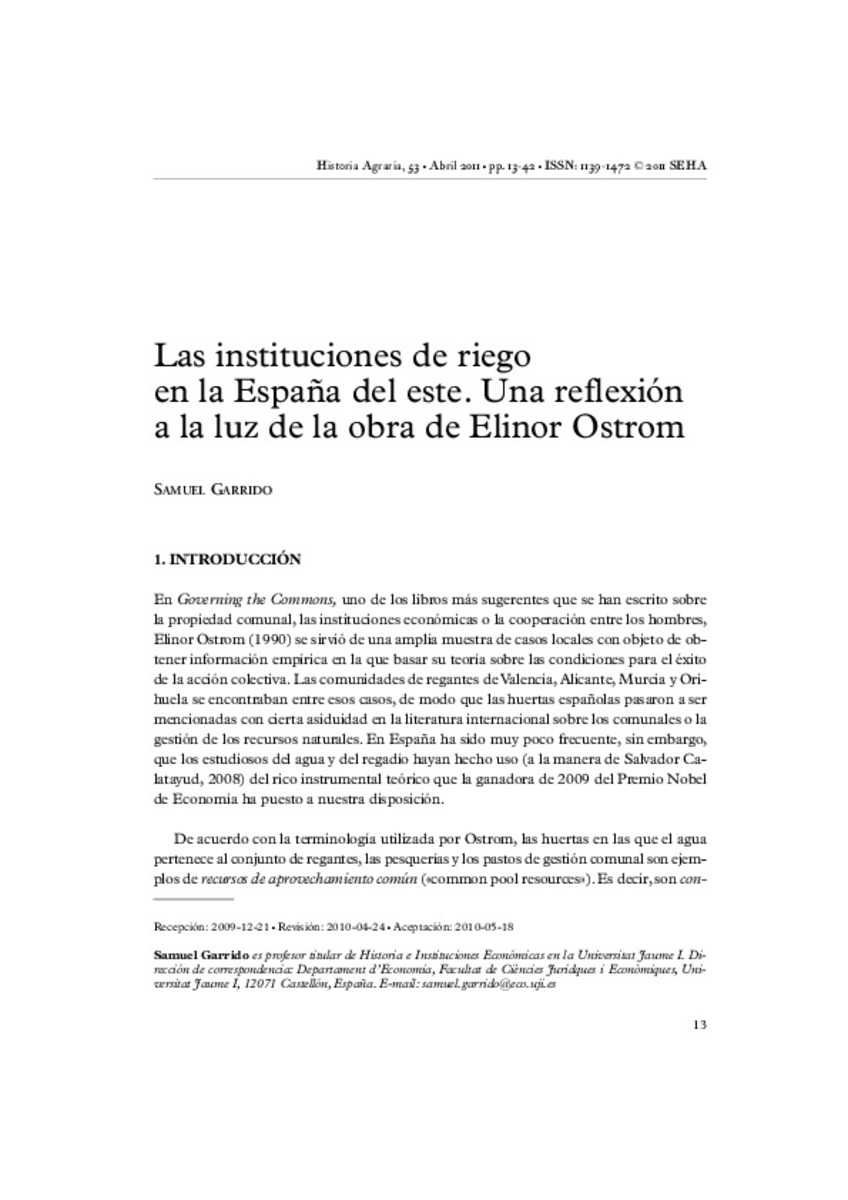Mostrar el registro sencillo del ítem
Las instituciones de riego en la España del este. Una reflexión a la luz de la obra de Elinor Ostrom.
| dc.contributor.author | Garrido, Samuel | |
| dc.date.accessioned | 2016-02-08T12:00:17Z | |
| dc.date.available | 2016-02-08T12:00:17Z | |
| dc.date.issued | 2011-04 | |
| dc.identifier.issn | 1139-1472 | |
| dc.identifier.uri | http://hdl.handle.net/10234/148985 | |
| dc.description.abstract | Con objeto de obtener información empírica sobre la que basar su teoría de la acción colectiva autoorganizada, en Governing the commons Elinor Ostrom estudió una amplia muestra de instituciones surgidas para regular el uso de recursos de aprovechamiento común. Ostrom observó que todas las instituciones estudiadas que había conseguido sobrevivir durante mucho tiempo se ajustaban a los mismos ocho "principios de diseño". Las comunidades de regantes de las huertas de Valencia, Murcia, Orihuela y Alicante estaban entre las instituciones analizadas. Pero la información que Ostrom utilizó sobre estas comunidades procedía de trabajo en los que se sostiene que funcionaban de manera democrática, o que los propios regantes tenían capacidad para modificar las ordenanzas de riego, algo con lo que la mayoría de especialistas españoles en la materia no está de acuerdo. En este artículo se analiza si los ocho "principios de diseño" estaban presentes o no en las huertas. Se llega a la conclusión de que en ocasiones no lo estaban, lo que no impide que el potente instrumental teórico desarrollado por Ostrom sea de gran ayuda para entender la lógica del funcionamiento de las instituciones del regadío tradicional español. | ca_CA |
| dc.description.abstract | In Governing the Commons, Elinor Ostrom studied a large sample of institutions developed toregulate the use of common pool resources, in order to obtain empirical data that could provide the basis for her theory of self‐organized collective action. Olstrom observed that all the analyzed institutions, which had survived for a long time, fulfilled the same eight «design principles». The communities of irrigators in the orchards of Valencia, Murcia, Orihuela, and Alicante were amongst the sample institutions. However, the information taken from them came from works that defended their democratic character or sustained that irrigators themselves had the capability to modify irrigation rules, views with which most Spanish experts disagree. In this article we study whether Olstrom ́s eight «design principles» were present in the orchards or not and reach the conclusion that sometimes they were not, a fact that does diminish the helpfulness of the powerful theoretical instruments developed by Ostrom, to understand the logic behind the workings of the Spanish irrigators’ institutions. | ca_CA |
| dc.format.extent | 30 p. | ca_CA |
| dc.format.mimetype | application/pdf | ca_CA |
| dc.language.iso | spa | ca_CA |
| dc.publisher | Sociedad Española de Historia Agraria (SEHA) | ca_CA |
| dc.relation.isPartOf | Historia agraria: Revista de agricultura e historia rural, nº 53, p. 13-42 | ca_CA |
| dc.rights | © 2011 SEHA | ca_CA |
| dc.rights.uri | http://rightsstatements.org/vocab/InC/1.0/ | * |
| dc.subject | Ostrom | ca_CA |
| dc.subject | comunidades de regantes | ca_CA |
| dc.subject | acción colectiva | ca_CA |
| dc.subject | propiedad comunal | ca_CA |
| dc.subject | irrigation communities | ca_CA |
| dc.subject | collective action | ca_CA |
| dc.subject | common pool resources | ca_CA |
| dc.title | Las instituciones de riego en la España del este. Una reflexión a la luz de la obra de Elinor Ostrom. | ca_CA |
| dc.type | info:eu-repo/semantics/article | ca_CA |
| dc.subject.jel | N53 | ca_CA |
| dc.subject.jel | N54 | ca_CA |
| dc.subject.jel | Q15 | ca_CA |
| dc.subject.jel | Q25 | ca_CA |
| dc.rights.accessRights | info:eu-repo/semantics/openAccess | ca_CA |
| dc.relation.publisherVersion | http://historiaagraria.com/info_articulo.php?id=542 | ca_CA |
| dc.type.version | info:eu-repo/semantics/publishedVersion | |
| dc.type.version | info:eu-repo/semantics/publishedVersion |







